Project Economics and Feasibility (Part 2): Literature Review Report
VerifiedAdded on 2023/01/11
|8
|2272
|77
Report
AI Summary
This report presents a literature review on project economics and feasibility, focusing on the Private Finance Initiative (PFI) and its role in public service delivery. It explores PFI costs, advantages, and disadvantages, emphasizing Value for Money (VFM) and the Public Sector Comparator (PSC) for evaluation. The review also examines the use of Life Cycle Assessment (LCA) and Multi-Criteria Analysis (MCA) in addressing environmental concerns and promoting sustainable practices, particularly in the context of renewable energy and public transit. Furthermore, it delves into risk allocation mechanisms, financial performance metrics, and the application of Multi-Criteria Decision Analysis (MCDA) and Social Impact Assessment (SIA) in project planning. The report also touches on supply chain management, feasibility analysis, and the factors influencing passenger satisfaction in transportation projects.
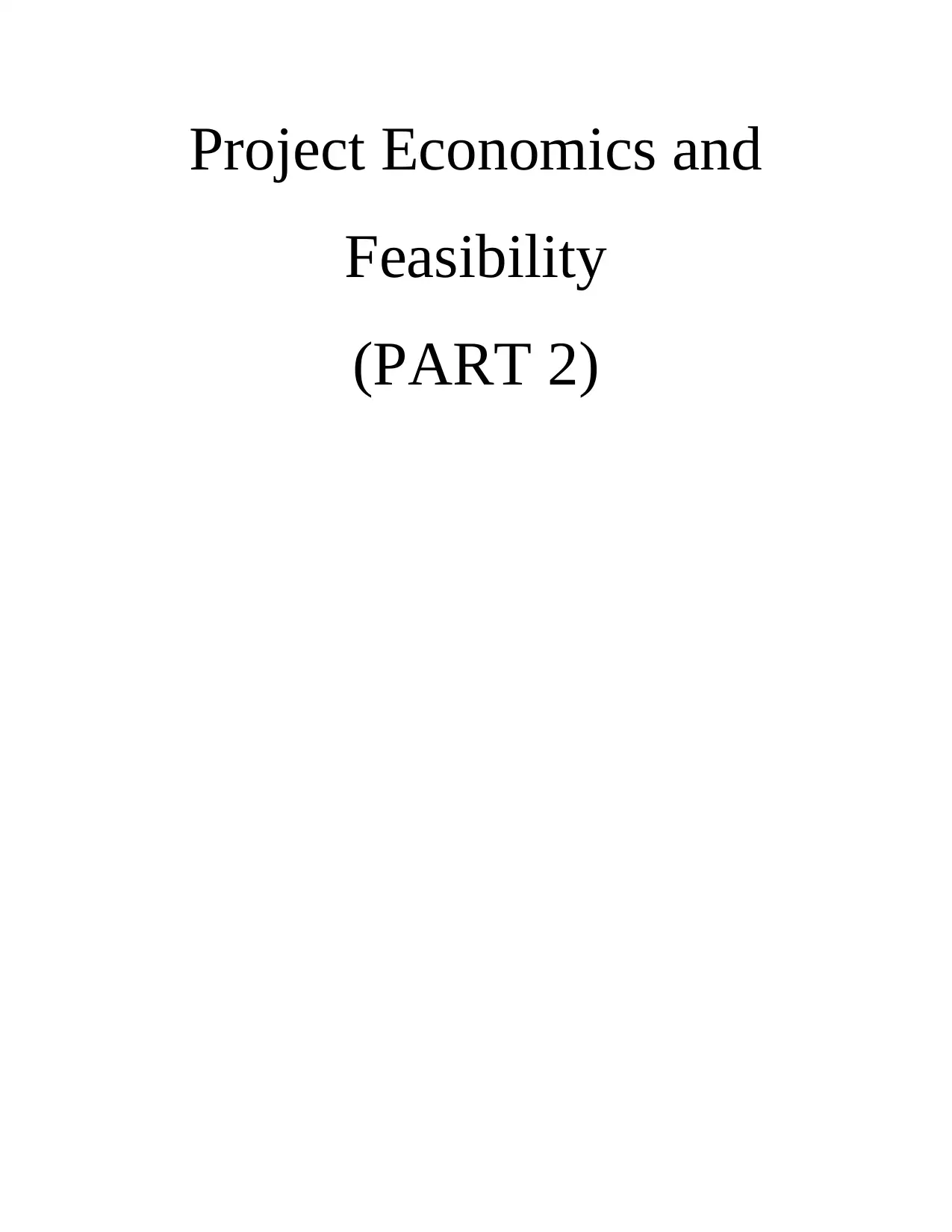
Project Economics and
Feasibility
(PART 2)
Feasibility
(PART 2)
Paraphrase This Document
Need a fresh take? Get an instant paraphrase of this document with our AI Paraphraser

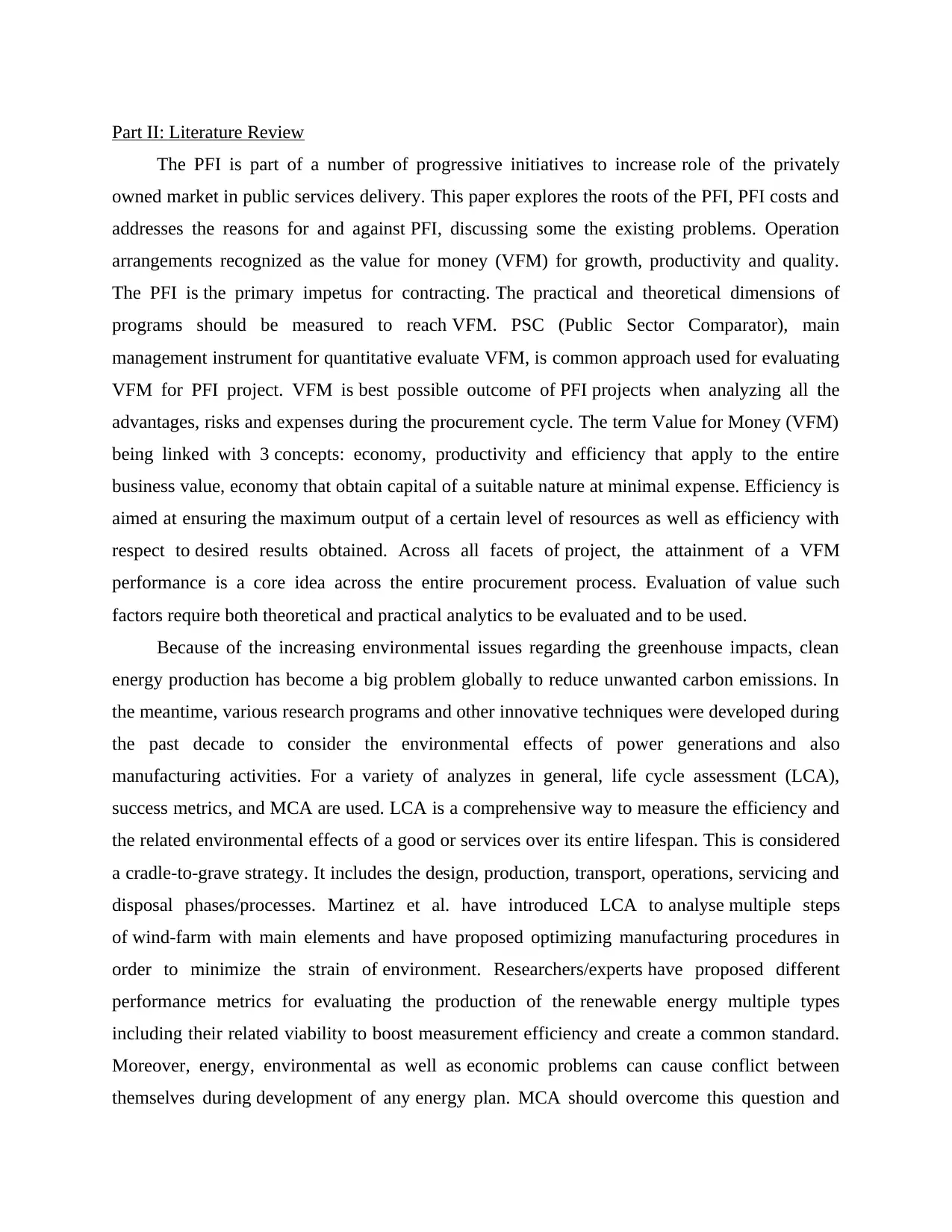
Part II: Literature Review
The PFI is part of a number of progressive initiatives to increase role of the privately
owned market in public services delivery. This paper explores the roots of the PFI, PFI costs and
addresses the reasons for and against PFI, discussing some the existing problems. Operation
arrangements recognized as the value for money (VFM) for growth, productivity and quality.
The PFI is the primary impetus for contracting. The practical and theoretical dimensions of
programs should be measured to reach VFM. PSC (Public Sector Comparator), main
management instrument for quantitative evaluate VFM, is common approach used for evaluating
VFM for PFI project. VFM is best possible outcome of PFI projects when analyzing all the
advantages, risks and expenses during the procurement cycle. The term Value for Money (VFM)
being linked with 3 concepts: economy, productivity and efficiency that apply to the entire
business value, economy that obtain capital of a suitable nature at minimal expense. Efficiency is
aimed at ensuring the maximum output of a certain level of resources as well as efficiency with
respect to desired results obtained. Across all facets of project, the attainment of a VFM
performance is a core idea across the entire procurement process. Evaluation of value such
factors require both theoretical and practical analytics to be evaluated and to be used.
Because of the increasing environmental issues regarding the greenhouse impacts, clean
energy production has become a big problem globally to reduce unwanted carbon emissions. In
the meantime, various research programs and other innovative techniques were developed during
the past decade to consider the environmental effects of power generations and also
manufacturing activities. For a variety of analyzes in general, life cycle assessment (LCA),
success metrics, and MCA are used. LCA is a comprehensive way to measure the efficiency and
the related environmental effects of a good or services over its entire lifespan. This is considered
a cradle-to-grave strategy. It includes the design, production, transport, operations, servicing and
disposal phases/processes. Martinez et al. have introduced LCA to analyse multiple steps
of wind-farm with main elements and have proposed optimizing manufacturing procedures in
order to minimize the strain of environment. Researchers/experts have proposed different
performance metrics for evaluating the production of the renewable energy multiple types
including their related viability to boost measurement efficiency and create a common standard.
Moreover, energy, environmental as well as economic problems can cause conflict between
themselves during development of any energy plan. MCA should overcome this question and
The PFI is part of a number of progressive initiatives to increase role of the privately
owned market in public services delivery. This paper explores the roots of the PFI, PFI costs and
addresses the reasons for and against PFI, discussing some the existing problems. Operation
arrangements recognized as the value for money (VFM) for growth, productivity and quality.
The PFI is the primary impetus for contracting. The practical and theoretical dimensions of
programs should be measured to reach VFM. PSC (Public Sector Comparator), main
management instrument for quantitative evaluate VFM, is common approach used for evaluating
VFM for PFI project. VFM is best possible outcome of PFI projects when analyzing all the
advantages, risks and expenses during the procurement cycle. The term Value for Money (VFM)
being linked with 3 concepts: economy, productivity and efficiency that apply to the entire
business value, economy that obtain capital of a suitable nature at minimal expense. Efficiency is
aimed at ensuring the maximum output of a certain level of resources as well as efficiency with
respect to desired results obtained. Across all facets of project, the attainment of a VFM
performance is a core idea across the entire procurement process. Evaluation of value such
factors require both theoretical and practical analytics to be evaluated and to be used.
Because of the increasing environmental issues regarding the greenhouse impacts, clean
energy production has become a big problem globally to reduce unwanted carbon emissions. In
the meantime, various research programs and other innovative techniques were developed during
the past decade to consider the environmental effects of power generations and also
manufacturing activities. For a variety of analyzes in general, life cycle assessment (LCA),
success metrics, and MCA are used. LCA is a comprehensive way to measure the efficiency and
the related environmental effects of a good or services over its entire lifespan. This is considered
a cradle-to-grave strategy. It includes the design, production, transport, operations, servicing and
disposal phases/processes. Martinez et al. have introduced LCA to analyse multiple steps
of wind-farm with main elements and have proposed optimizing manufacturing procedures in
order to minimize the strain of environment. Researchers/experts have proposed different
performance metrics for evaluating the production of the renewable energy multiple types
including their related viability to boost measurement efficiency and create a common standard.
Moreover, energy, environmental as well as economic problems can cause conflict between
themselves during development of any energy plan. MCA should overcome this question and
⊘ This is a preview!⊘
Do you want full access?
Subscribe today to unlock all pages.

Trusted by 1+ million students worldwide
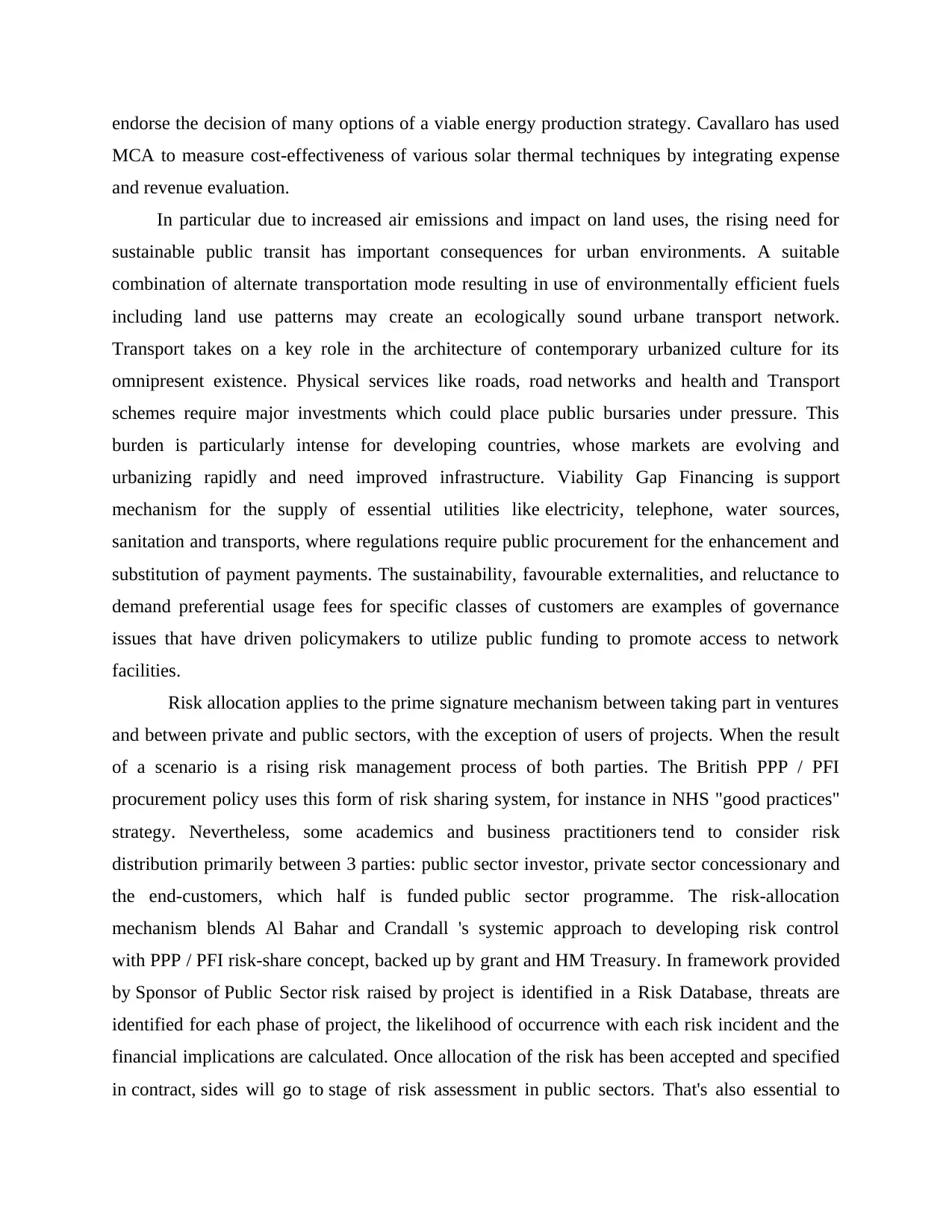
endorse the decision of many options of a viable energy production strategy. Cavallaro has used
MCA to measure cost-effectiveness of various solar thermal techniques by integrating expense
and revenue evaluation.
In particular due to increased air emissions and impact on land uses, the rising need for
sustainable public transit has important consequences for urban environments. A suitable
combination of alternate transportation mode resulting in use of environmentally efficient fuels
including land use patterns may create an ecologically sound urbane transport network.
Transport takes on a key role in the architecture of contemporary urbanized culture for its
omnipresent existence. Physical services like roads, road networks and health and Transport
schemes require major investments which could place public bursaries under pressure. This
burden is particularly intense for developing countries, whose markets are evolving and
urbanizing rapidly and need improved infrastructure. Viability Gap Financing is support
mechanism for the supply of essential utilities like electricity, telephone, water sources,
sanitation and transports, where regulations require public procurement for the enhancement and
substitution of payment payments. The sustainability, favourable externalities, and reluctance to
demand preferential usage fees for specific classes of customers are examples of governance
issues that have driven policymakers to utilize public funding to promote access to network
facilities.
Risk allocation applies to the prime signature mechanism between taking part in ventures
and between private and public sectors, with the exception of users of projects. When the result
of a scenario is a rising risk management process of both parties. The British PPP / PFI
procurement policy uses this form of risk sharing system, for instance in NHS "good practices"
strategy. Nevertheless, some academics and business practitioners tend to consider risk
distribution primarily between 3 parties: public sector investor, private sector concessionary and
the end-customers, which half is funded public sector programme. The risk-allocation
mechanism blends Al Bahar and Crandall 's systemic approach to developing risk control
with PPP / PFI risk-share concept, backed up by grant and HM Treasury. In framework provided
by Sponsor of Public Sector risk raised by project is identified in a Risk Database, threats are
identified for each phase of project, the likelihood of occurrence with each risk incident and the
financial implications are calculated. Once allocation of the risk has been accepted and specified
in contract, sides will go to stage of risk assessment in public sectors. That's also essential to
MCA to measure cost-effectiveness of various solar thermal techniques by integrating expense
and revenue evaluation.
In particular due to increased air emissions and impact on land uses, the rising need for
sustainable public transit has important consequences for urban environments. A suitable
combination of alternate transportation mode resulting in use of environmentally efficient fuels
including land use patterns may create an ecologically sound urbane transport network.
Transport takes on a key role in the architecture of contemporary urbanized culture for its
omnipresent existence. Physical services like roads, road networks and health and Transport
schemes require major investments which could place public bursaries under pressure. This
burden is particularly intense for developing countries, whose markets are evolving and
urbanizing rapidly and need improved infrastructure. Viability Gap Financing is support
mechanism for the supply of essential utilities like electricity, telephone, water sources,
sanitation and transports, where regulations require public procurement for the enhancement and
substitution of payment payments. The sustainability, favourable externalities, and reluctance to
demand preferential usage fees for specific classes of customers are examples of governance
issues that have driven policymakers to utilize public funding to promote access to network
facilities.
Risk allocation applies to the prime signature mechanism between taking part in ventures
and between private and public sectors, with the exception of users of projects. When the result
of a scenario is a rising risk management process of both parties. The British PPP / PFI
procurement policy uses this form of risk sharing system, for instance in NHS "good practices"
strategy. Nevertheless, some academics and business practitioners tend to consider risk
distribution primarily between 3 parties: public sector investor, private sector concessionary and
the end-customers, which half is funded public sector programme. The risk-allocation
mechanism blends Al Bahar and Crandall 's systemic approach to developing risk control
with PPP / PFI risk-share concept, backed up by grant and HM Treasury. In framework provided
by Sponsor of Public Sector risk raised by project is identified in a Risk Database, threats are
identified for each phase of project, the likelihood of occurrence with each risk incident and the
financial implications are calculated. Once allocation of the risk has been accepted and specified
in contract, sides will go to stage of risk assessment in public sectors. That's also essential to
Paraphrase This Document
Need a fresh take? Get an instant paraphrase of this document with our AI Paraphraser
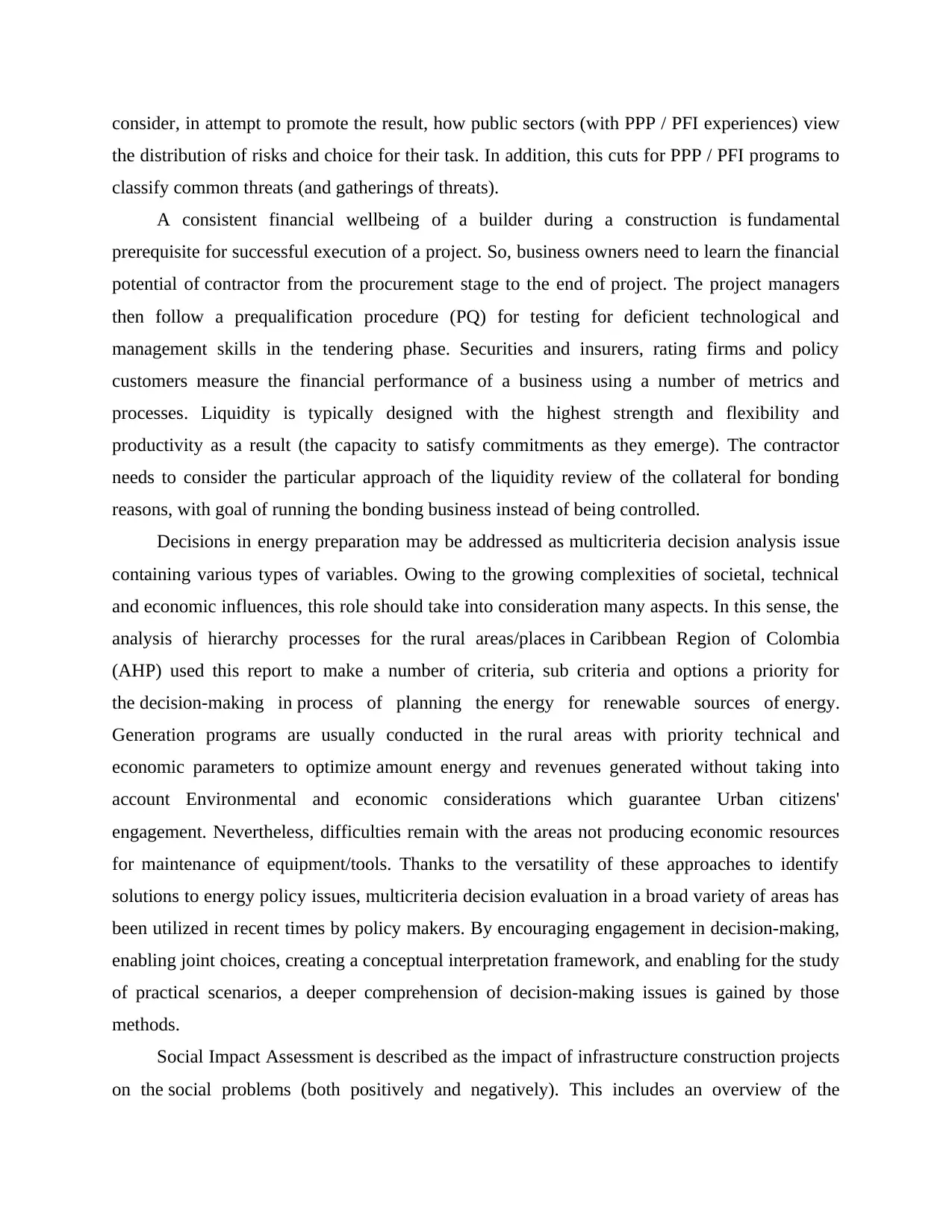
consider, in attempt to promote the result, how public sectors (with PPP / PFI experiences) view
the distribution of risks and choice for their task. In addition, this cuts for PPP / PFI programs to
classify common threats (and gatherings of threats).
A consistent financial wellbeing of a builder during a construction is fundamental
prerequisite for successful execution of a project. So, business owners need to learn the financial
potential of contractor from the procurement stage to the end of project. The project managers
then follow a prequalification procedure (PQ) for testing for deficient technological and
management skills in the tendering phase. Securities and insurers, rating firms and policy
customers measure the financial performance of a business using a number of metrics and
processes. Liquidity is typically designed with the highest strength and flexibility and
productivity as a result (the capacity to satisfy commitments as they emerge). The contractor
needs to consider the particular approach of the liquidity review of the collateral for bonding
reasons, with goal of running the bonding business instead of being controlled.
Decisions in energy preparation may be addressed as multicriteria decision analysis issue
containing various types of variables. Owing to the growing complexities of societal, technical
and economic influences, this role should take into consideration many aspects. In this sense, the
analysis of hierarchy processes for the rural areas/places in Caribbean Region of Colombia
(AHP) used this report to make a number of criteria, sub criteria and options a priority for
the decision-making in process of planning the energy for renewable sources of energy.
Generation programs are usually conducted in the rural areas with priority technical and
economic parameters to optimize amount energy and revenues generated without taking into
account Environmental and economic considerations which guarantee Urban citizens'
engagement. Nevertheless, difficulties remain with the areas not producing economic resources
for maintenance of equipment/tools. Thanks to the versatility of these approaches to identify
solutions to energy policy issues, multicriteria decision evaluation in a broad variety of areas has
been utilized in recent times by policy makers. By encouraging engagement in decision-making,
enabling joint choices, creating a conceptual interpretation framework, and enabling for the study
of practical scenarios, a deeper comprehension of decision-making issues is gained by those
methods.
Social Impact Assessment is described as the impact of infrastructure construction projects
on the social problems (both positively and negatively). This includes an overview of the
the distribution of risks and choice for their task. In addition, this cuts for PPP / PFI programs to
classify common threats (and gatherings of threats).
A consistent financial wellbeing of a builder during a construction is fundamental
prerequisite for successful execution of a project. So, business owners need to learn the financial
potential of contractor from the procurement stage to the end of project. The project managers
then follow a prequalification procedure (PQ) for testing for deficient technological and
management skills in the tendering phase. Securities and insurers, rating firms and policy
customers measure the financial performance of a business using a number of metrics and
processes. Liquidity is typically designed with the highest strength and flexibility and
productivity as a result (the capacity to satisfy commitments as they emerge). The contractor
needs to consider the particular approach of the liquidity review of the collateral for bonding
reasons, with goal of running the bonding business instead of being controlled.
Decisions in energy preparation may be addressed as multicriteria decision analysis issue
containing various types of variables. Owing to the growing complexities of societal, technical
and economic influences, this role should take into consideration many aspects. In this sense, the
analysis of hierarchy processes for the rural areas/places in Caribbean Region of Colombia
(AHP) used this report to make a number of criteria, sub criteria and options a priority for
the decision-making in process of planning the energy for renewable sources of energy.
Generation programs are usually conducted in the rural areas with priority technical and
economic parameters to optimize amount energy and revenues generated without taking into
account Environmental and economic considerations which guarantee Urban citizens'
engagement. Nevertheless, difficulties remain with the areas not producing economic resources
for maintenance of equipment/tools. Thanks to the versatility of these approaches to identify
solutions to energy policy issues, multicriteria decision evaluation in a broad variety of areas has
been utilized in recent times by policy makers. By encouraging engagement in decision-making,
enabling joint choices, creating a conceptual interpretation framework, and enabling for the study
of practical scenarios, a deeper comprehension of decision-making issues is gained by those
methods.
Social Impact Assessment is described as the impact of infrastructure construction projects
on the social problems (both positively and negatively). This includes an overview of the
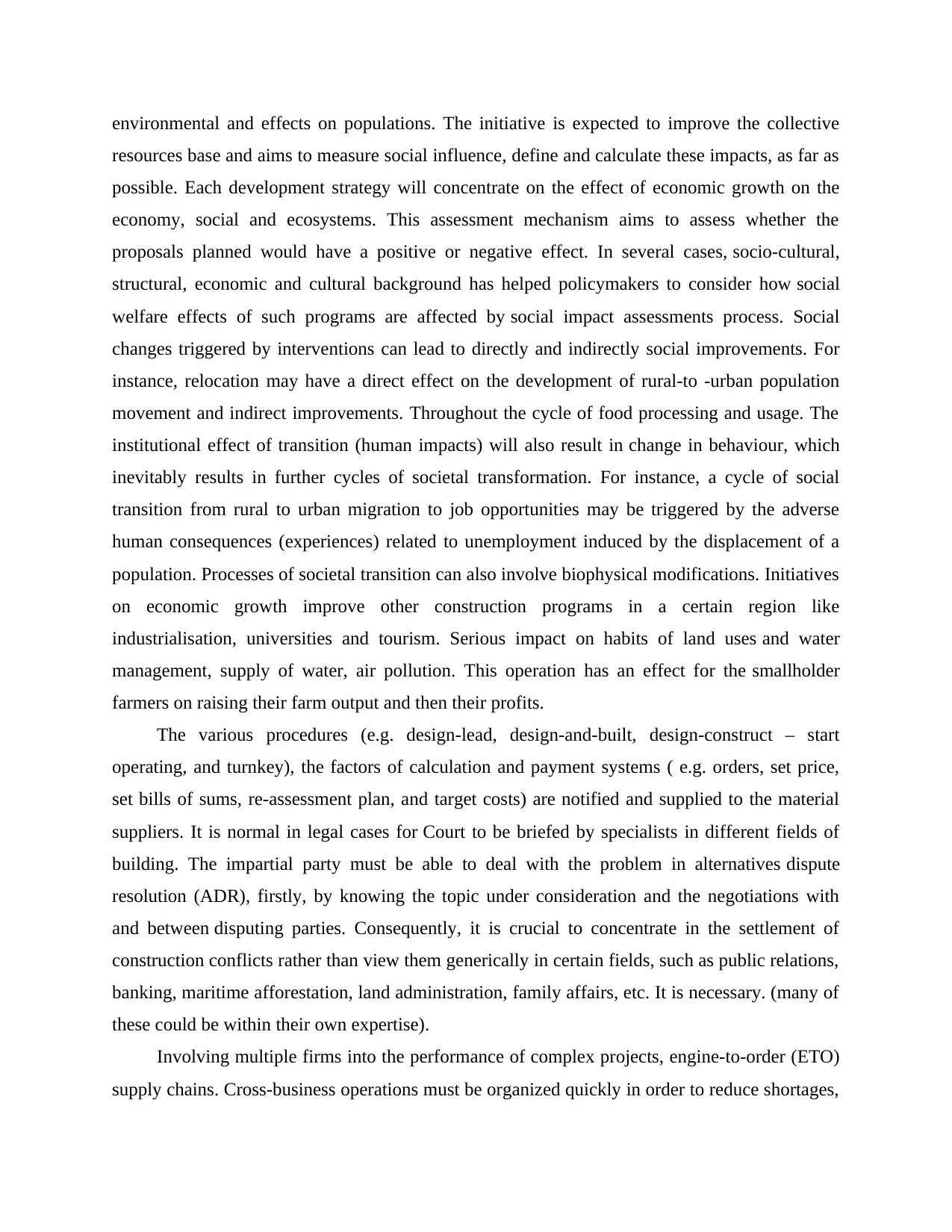
environmental and effects on populations. The initiative is expected to improve the collective
resources base and aims to measure social influence, define and calculate these impacts, as far as
possible. Each development strategy will concentrate on the effect of economic growth on the
economy, social and ecosystems. This assessment mechanism aims to assess whether the
proposals planned would have a positive or negative effect. In several cases, socio-cultural,
structural, economic and cultural background has helped policymakers to consider how social
welfare effects of such programs are affected by social impact assessments process. Social
changes triggered by interventions can lead to directly and indirectly social improvements. For
instance, relocation may have a direct effect on the development of rural-to -urban population
movement and indirect improvements. Throughout the cycle of food processing and usage. The
institutional effect of transition (human impacts) will also result in change in behaviour, which
inevitably results in further cycles of societal transformation. For instance, a cycle of social
transition from rural to urban migration to job opportunities may be triggered by the adverse
human consequences (experiences) related to unemployment induced by the displacement of a
population. Processes of societal transition can also involve biophysical modifications. Initiatives
on economic growth improve other construction programs in a certain region like
industrialisation, universities and tourism. Serious impact on habits of land uses and water
management, supply of water, air pollution. This operation has an effect for the smallholder
farmers on raising their farm output and then their profits.
The various procedures (e.g. design-lead, design-and-built, design-construct – start
operating, and turnkey), the factors of calculation and payment systems ( e.g. orders, set price,
set bills of sums, re-assessment plan, and target costs) are notified and supplied to the material
suppliers. It is normal in legal cases for Court to be briefed by specialists in different fields of
building. The impartial party must be able to deal with the problem in alternatives dispute
resolution (ADR), firstly, by knowing the topic under consideration and the negotiations with
and between disputing parties. Consequently, it is crucial to concentrate in the settlement of
construction conflicts rather than view them generically in certain fields, such as public relations,
banking, maritime afforestation, land administration, family affairs, etc. It is necessary. (many of
these could be within their own expertise).
Involving multiple firms into the performance of complex projects, engine-to-order (ETO)
supply chains. Cross-business operations must be organized quickly in order to reduce shortages,
resources base and aims to measure social influence, define and calculate these impacts, as far as
possible. Each development strategy will concentrate on the effect of economic growth on the
economy, social and ecosystems. This assessment mechanism aims to assess whether the
proposals planned would have a positive or negative effect. In several cases, socio-cultural,
structural, economic and cultural background has helped policymakers to consider how social
welfare effects of such programs are affected by social impact assessments process. Social
changes triggered by interventions can lead to directly and indirectly social improvements. For
instance, relocation may have a direct effect on the development of rural-to -urban population
movement and indirect improvements. Throughout the cycle of food processing and usage. The
institutional effect of transition (human impacts) will also result in change in behaviour, which
inevitably results in further cycles of societal transformation. For instance, a cycle of social
transition from rural to urban migration to job opportunities may be triggered by the adverse
human consequences (experiences) related to unemployment induced by the displacement of a
population. Processes of societal transition can also involve biophysical modifications. Initiatives
on economic growth improve other construction programs in a certain region like
industrialisation, universities and tourism. Serious impact on habits of land uses and water
management, supply of water, air pollution. This operation has an effect for the smallholder
farmers on raising their farm output and then their profits.
The various procedures (e.g. design-lead, design-and-built, design-construct – start
operating, and turnkey), the factors of calculation and payment systems ( e.g. orders, set price,
set bills of sums, re-assessment plan, and target costs) are notified and supplied to the material
suppliers. It is normal in legal cases for Court to be briefed by specialists in different fields of
building. The impartial party must be able to deal with the problem in alternatives dispute
resolution (ADR), firstly, by knowing the topic under consideration and the negotiations with
and between disputing parties. Consequently, it is crucial to concentrate in the settlement of
construction conflicts rather than view them generically in certain fields, such as public relations,
banking, maritime afforestation, land administration, family affairs, etc. It is necessary. (many of
these could be within their own expertise).
Involving multiple firms into the performance of complex projects, engine-to-order (ETO)
supply chains. Cross-business operations must be organized quickly in order to reduce shortages,
⊘ This is a preview!⊘
Do you want full access?
Subscribe today to unlock all pages.

Trusted by 1+ million students worldwide
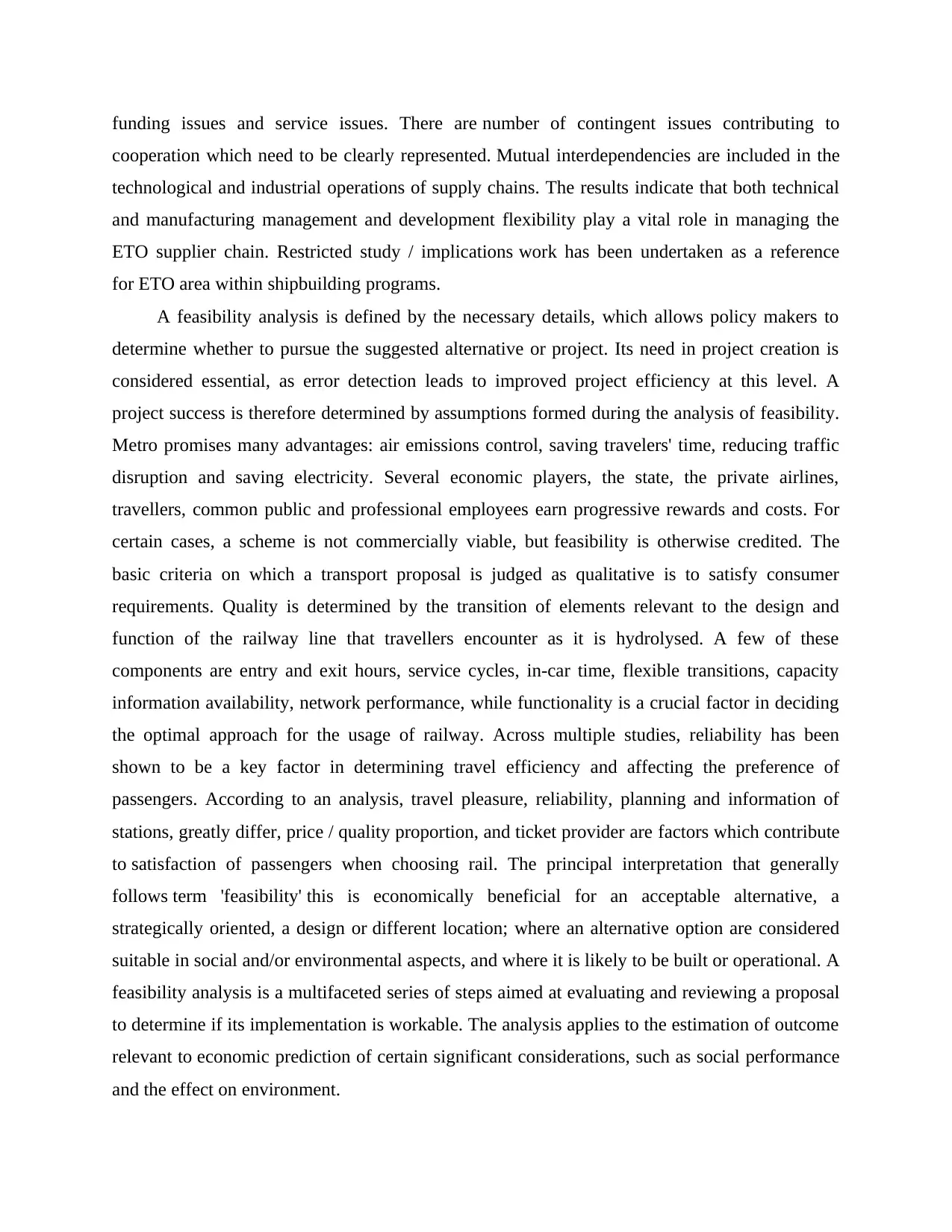
funding issues and service issues. There are number of contingent issues contributing to
cooperation which need to be clearly represented. Mutual interdependencies are included in the
technological and industrial operations of supply chains. The results indicate that both technical
and manufacturing management and development flexibility play a vital role in managing the
ETO supplier chain. Restricted study / implications work has been undertaken as a reference
for ETO area within shipbuilding programs.
A feasibility analysis is defined by the necessary details, which allows policy makers to
determine whether to pursue the suggested alternative or project. Its need in project creation is
considered essential, as error detection leads to improved project efficiency at this level. A
project success is therefore determined by assumptions formed during the analysis of feasibility.
Metro promises many advantages: air emissions control, saving travelers' time, reducing traffic
disruption and saving electricity. Several economic players, the state, the private airlines,
travellers, common public and professional employees earn progressive rewards and costs. For
certain cases, a scheme is not commercially viable, but feasibility is otherwise credited. The
basic criteria on which a transport proposal is judged as qualitative is to satisfy consumer
requirements. Quality is determined by the transition of elements relevant to the design and
function of the railway line that travellers encounter as it is hydrolysed. A few of these
components are entry and exit hours, service cycles, in-car time, flexible transitions, capacity
information availability, network performance, while functionality is a crucial factor in deciding
the optimal approach for the usage of railway. Across multiple studies, reliability has been
shown to be a key factor in determining travel efficiency and affecting the preference of
passengers. According to an analysis, travel pleasure, reliability, planning and information of
stations, greatly differ, price / quality proportion, and ticket provider are factors which contribute
to satisfaction of passengers when choosing rail. The principal interpretation that generally
follows term 'feasibility' this is economically beneficial for an acceptable alternative, a
strategically oriented, a design or different location; where an alternative option are considered
suitable in social and/or environmental aspects, and where it is likely to be built or operational. A
feasibility analysis is a multifaceted series of steps aimed at evaluating and reviewing a proposal
to determine if its implementation is workable. The analysis applies to the estimation of outcome
relevant to economic prediction of certain significant considerations, such as social performance
and the effect on environment.
cooperation which need to be clearly represented. Mutual interdependencies are included in the
technological and industrial operations of supply chains. The results indicate that both technical
and manufacturing management and development flexibility play a vital role in managing the
ETO supplier chain. Restricted study / implications work has been undertaken as a reference
for ETO area within shipbuilding programs.
A feasibility analysis is defined by the necessary details, which allows policy makers to
determine whether to pursue the suggested alternative or project. Its need in project creation is
considered essential, as error detection leads to improved project efficiency at this level. A
project success is therefore determined by assumptions formed during the analysis of feasibility.
Metro promises many advantages: air emissions control, saving travelers' time, reducing traffic
disruption and saving electricity. Several economic players, the state, the private airlines,
travellers, common public and professional employees earn progressive rewards and costs. For
certain cases, a scheme is not commercially viable, but feasibility is otherwise credited. The
basic criteria on which a transport proposal is judged as qualitative is to satisfy consumer
requirements. Quality is determined by the transition of elements relevant to the design and
function of the railway line that travellers encounter as it is hydrolysed. A few of these
components are entry and exit hours, service cycles, in-car time, flexible transitions, capacity
information availability, network performance, while functionality is a crucial factor in deciding
the optimal approach for the usage of railway. Across multiple studies, reliability has been
shown to be a key factor in determining travel efficiency and affecting the preference of
passengers. According to an analysis, travel pleasure, reliability, planning and information of
stations, greatly differ, price / quality proportion, and ticket provider are factors which contribute
to satisfaction of passengers when choosing rail. The principal interpretation that generally
follows term 'feasibility' this is economically beneficial for an acceptable alternative, a
strategically oriented, a design or different location; where an alternative option are considered
suitable in social and/or environmental aspects, and where it is likely to be built or operational. A
feasibility analysis is a multifaceted series of steps aimed at evaluating and reviewing a proposal
to determine if its implementation is workable. The analysis applies to the estimation of outcome
relevant to economic prediction of certain significant considerations, such as social performance
and the effect on environment.
Paraphrase This Document
Need a fresh take? Get an instant paraphrase of this document with our AI Paraphraser

1 out of 8
Related Documents
Your All-in-One AI-Powered Toolkit for Academic Success.
+13062052269
info@desklib.com
Available 24*7 on WhatsApp / Email
![[object Object]](/_next/static/media/star-bottom.7253800d.svg)
Unlock your academic potential
Copyright © 2020–2025 A2Z Services. All Rights Reserved. Developed and managed by ZUCOL.



